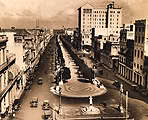|
Over the years, Cuba has been
excellently represented through photography. On April 5th,
1840 a newspaper in Havana disclosed information about the
first photographic apparatus on the island, which had arrived
the previous month and had been damaged during the journey.
Pedro Tellez de Giron, the owner of the camera, took the
first photograph as reported. He shot it from a balcony
at the Palacio de los Capitanes Generales. Apparently this
picture was lost or ruined by time. At the beginning of
the Independence War, photographer Jose Gomez de la Carrera
made a press report that set the basis for modern photojournalism
and established standards hardly ever surpassed. The first
publication specialised on the subject, Photographic Bulletin,
was founded in 1882. Publisher Soler Alvarez released the
book Photography at everyone's reach, in Havana, in 1887.
Photographers like Generoso Funcasta, Lopez Ortiz, Martinez
Hilla, Ernesto Ocaña and others have portrayed the period
from the beginning of the century through the '30s. During
this time, photography gained great importance through different
periodic publications. We include a special mention for
the works of Joaquin Blez, a highly acclaimed bourgeoisie
photographer, who displayed exquisite taste in handling
nudes and portraits. Through the cameras of Constantino
Arias and Moises Hernandez, in the records of the Diary
of Cuba in Santiago, or the Navy's Diary in Havana, and
in the filling cabinets of Bohemia magazine, we can find
a complete vision of the rapid social events that took place
on the island during the years prior to the revolution.
The revolution came and with it another group of photographers,
they took the more widely published pictures of Cuban history.
Among the most acknowledged from these decades are Alberto
Diaz (Korda), Raul Corrales, Osvaldo Salas (he covered Fidel's
visit to New York City in1955), and Ernesto Fernandez. We
get a sight of the period after the revolution from the
works of authors like "Marucha", "Mayito" and Roberto Salas.
Sponsored by Casa de las Americas, the "First Sample of
Cuban Culture" held on 1966, blended photography into the
concert of all arts. In 1976 the "First Sample of Cuban
Photography" was exhibited in Mexico; its success propitiated
another exhibit a year later "History of Cuban Photography",
in the same city. In recent years photographers are carrying
out their work via photographic essays or performance. Outstanding
for the beauty and contents of their compositions are the
works of: Marta Maria Perez, Rene Peña, Abigail Gonzalez,
Julio Larramendi (our staff photographer) and Cirenaica
Moreira. Many of today's works are more illustrative than
any documentary; others range from poetry to irony. The
arrival of the Pope in Cuba opened yet another chapter in
Cuban photography, one of many that has contributed to the
last century.
One of the oldest cameras on
the island can be seen in use today at the entrance of the
Capital building, Havana. Thousands of tourists take home
prints from this early camera every week.
|



|













































